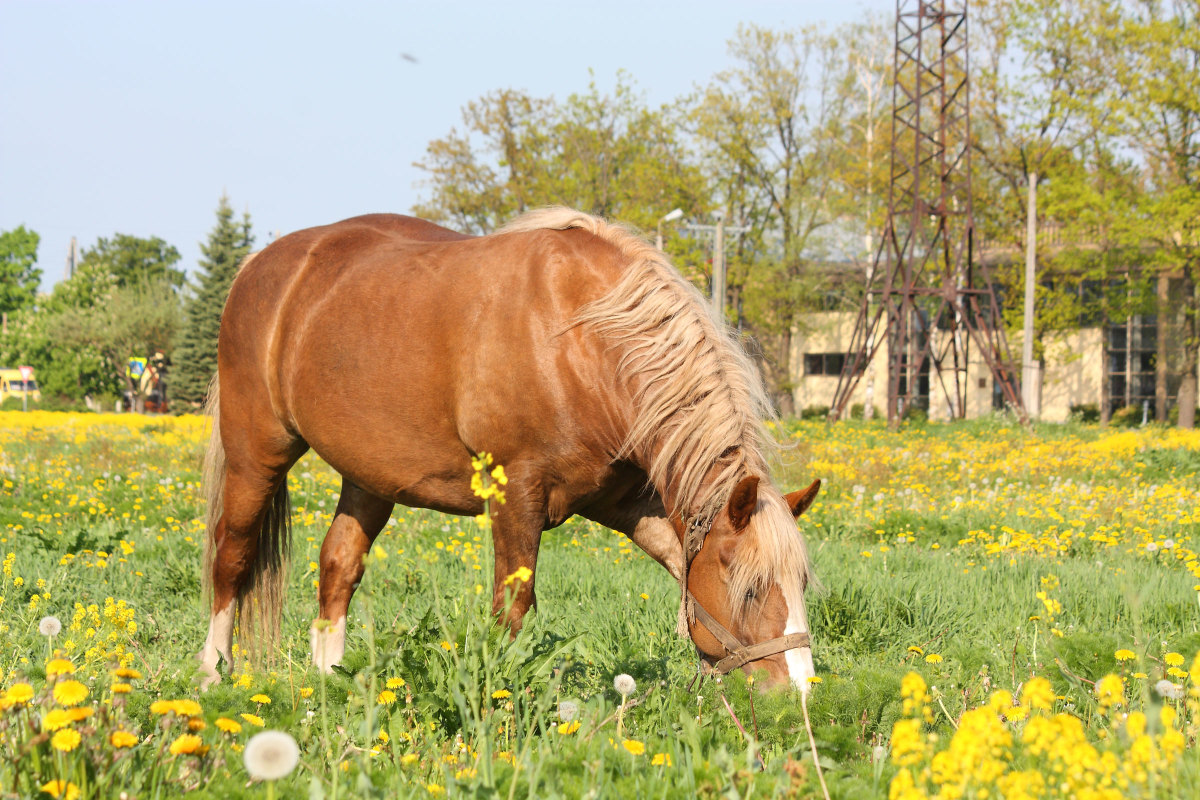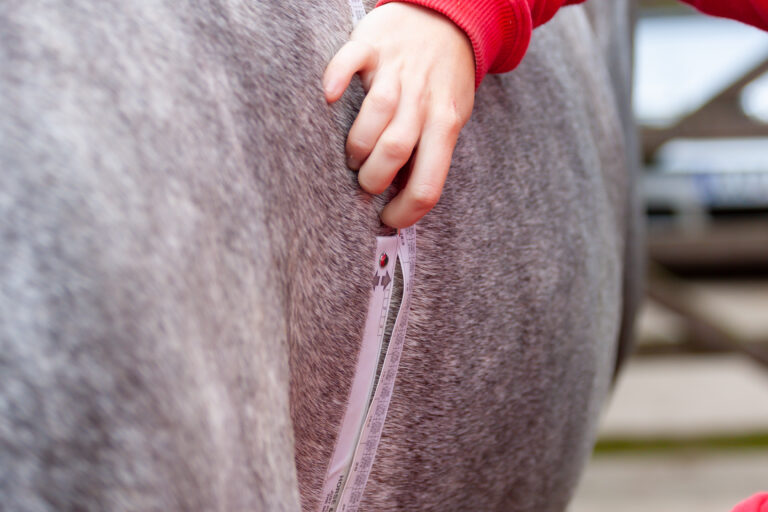
iStock/Virgonira
Obesity is as problematic for horses as it is for humans. The root causes are often the same in both—too many calories and not enough exercise. Left unchecked, excess weight can lead to the development of other, more serious conditions.
Humans are in control of what and how much horses eat, and horses don’t have a concept of what it means to eat too much, said Colleen Best, DVM, PhD, of the Ontario Veterinary College.
“The population in America is so overweight that we start to normalize it and downplay its significance,” Best said. “If the owners don’t believe their horses are fat, they won’t do anything to change it.”
The reality is that dieting isn’t fun, and it takes effort.
“Nobody likes putting themselves on a diet,” said Carey Williams, PhD, an equine extension specialist at Rutgers University with a focus on nutrition. “So horse owners find it hard to put their horses on a diet, but they have to understand that a little tough love is needed.”
Veterinary schools don’t extensively cover nutrition, and that can create an uneasiness in new veterinarians about addressing this problem with clients.
“You do learn enough to start the conversation. You can talk about how obesity leads to lameness, arthritis and metabolic syndrome,” Best said. “And you can educate an owner about the body condition score.”
UC Davis Equine Field Service clinical faculty Emily Berryhill, DVM, added that horse owners tend to hear what they want to hear. “Sometimes I think it’s easier for owners to only hear the bits and pieces of our conversations that either are easy to understand or are intuitive, and not see the whole picture,” she said.
A barn manager’s or horse owner’s management practices directly impact the horse’s weight. Since these folks don’t often understand equine nutrition, it’s the veterinarian’s job to explain and educate the horse owner about nutrition and body condition score.
The Root Cause
When working with a client who has an overweight horse, the first step is understanding the management practices and attitudes toward feeding routines. Spring visits for vaccinations and other routine work are a good time to begin conversations with owners about the importance of nutrition and a horse’s overall body condition. Asking questions about how the horse is fed can yield interesting feedback about what is contributing to a horse being fat.
“Owners overfeed because they feel they are taking the best care of their horses,” Berryhill said. “To them, food equals love.”
These horse owners feel guilty if they don’t give one horse grain when every other horse in the barn receives some.
“We’ve all seen that pony that gets a handful of food, but can’t fit through the door,” Best said. “It’s not much different from the quintessential grandma who loves to feed her family. We don’t want to take away that joy of giving food, but we have to move grandma’s focus away from fried foods to veggies.”
It’s also likely that the horse’s owner just doesn’t believe the horse is fat. They don’t see the fatty deposits or fat pads that a veterinarian does. Best once had a client who also owned a dairy farm. The horse was turned out on lush pasture with the cattle. Taking the horse off pasture wasn’t an option. Best spent 40 minutes trying to explain that the horse was overweight. The owner simply couldn’t see it.
“I finally had to tell her that if her horse were a human, it would be a candidate for gastric bypass surgery,” Best said. “As soon as she understood how dire the situation was, she agreed to using a grazing muzzle.”
Other horse owners find enjoyment in hearing their horses eat. Best once had a client who owned draft horses that were so overweight they were lame, but he wasn’t willing to eliminate the evening feed.
“Listening to the horses chew was his stress relief,” she said. “That was important to understand when creating a management plan to help the horses lose weight and maintain the proper weight.”
Chances are, the horse owners or caretakers are uneducated about nutrition and body condition scores.
“Horse owners don’t always understand that a horse needs to be fed 2% of its body weight, and if overweight, that should be cut down to 1.75% or 1.5%,” Williams said. “They tend to just throw hay and grain at the horse and don’t think about how that relates to the horse’s daily intake.”
Many horse owners also feel that a horse must have grain. But if they are feeding a good-quality forage, they are typically meeting all the horse’s needs.
During an annual Junior Breeders Symposium that Williams helps host, she teaches attendees how to body condition score and use a weight tape, then use the results to determine an appropriate ration.
It’s also important to understand what access the owner has to the horse. A horse owner who purchases the feed and provides the care has direct control over what and how much the horse is eating. That individual might also be more open to sending the hay out for an analysis.
“If the horse is at a boarding facility where the owner has less control, then the barn manager needs to be brought into the conversation,” Best said.
Thinking Outside the Box
Change can be difficult to accept. It means adapting to a new process and taking time to weigh out feed and hay rather than eyeballing the ration.
“Many times, owners are fortunate enough to not have had problems, which makes it challenging to convince them to change their program when it seemingly was fine before,” Berryhill said. “It can also be quite difficult to convince owners that changing their feeding programs is absolutely necessary when the presenting medical problem is something that may seem unrelated, like feet or joint issues.”
That’s when thinking outside the box benefits the horse and its owner. When an owner or caretaker won’t conduct a hay analysis, Berryhill encourages the client to switch to a variety that generally has lower sugar levels.
“If an owner won’t switch hay, I then recommend that they soak their current hay. This isn’t the best approach, but is better than nothing,” Berryhill said. Soaking hay can actually remove up to 30% of the sugar content in hay, which can significantly reduce the calorie content the horse is eating, Williams added.
There are creative ways to encourage owners to increase their horses’ amount of exercise, such as a part-lease or shared riding agreement.
“I’ve had owners who want to get involved and are looking for a fun way to help their horse lose weight, so I had them jog alongside their horse part way through a ride, then mount up and ride the rest of the routine,” she said. “Another way to add exercise is to try a new discipline.”
Best said that small animal practices excel at keeping in touch with customers, especially those with overweight pets. They take a “Jenny Craig” approach and encourage pet owners to bring their pets for weigh-ins. A similar approach can work with equines.
“You can encourage a horse owner to get a weight tape and use it at different intervals within the month and have them record the measurement on a calendar,” she said. “It’s not perfect, but when used consistently, it can help them get the horse’s weight down.”
The key is making solutions manageable.
“I try to make the ultimate diet plan as simple as possible, with a good source of appropriate forage and a ration balancer,” Berryhill added. “Once the foundation diet is established, it can certainly be tinkered with over time.”
Grazing muzzles, nibble nets, slow feeders and mowing pastures are other methods horse owners can use to slow a fast eater and limit overall intake.
According to Williams, proven research shows that with slow feeders, it can take a horse two to three times longer to work through its hay. “And a grazing muzzle can cut down intake by 30% to 80%, depending on the horse and the pasture they are in,” she said.
Food for Thought
Starting the conversation about nutrition and body condition scores is the most important first step. Developing a relationship based on trust and genuine interest in the horse’s well-being establishes the foundation for tackling the topic of obesity in horses.
“Ask a lot of questions in a nonjudgmental way,” Best said. “You can learn a lot about what is contributing to the obesity and how to create a strategy for managing it.”
There are countless continuing education programs that are available for veterinarians who want to learn more about nutrition. Equine nutritionists always welcome the opportunity to consult with veterinarians and horse owners to create the best diet for the horses. Williams encourages veterinarians to visit extensionhorses.org, an online resource that includes research-driven, university-based, unbiased information on a wide range of topics, including nutrition.
Each state also has an extension agency that often includes a nutritional specialist. For states that don’t have a nutritional specialist, those within the same geographic region often have partnerships and are willing to assist.
“This is a free service paid for by state taxpayer dollars, so you might as well use it,” Williams said. “To find your states extension service just Google “(your state) Cooperative Extension” and it will give you the state site—then you can find your local county or regional office.”
Take-Home Message
There is no quick fix to managing an overweight horse or its owner. Management of obesity occurs over the long haul and requires regular check-ins.
“Continued communication with the horse owner to follow up and see how things are going is key to success and beneficial for the horse, the owner’s continued education and the veterinarian,” Berryhill said.




